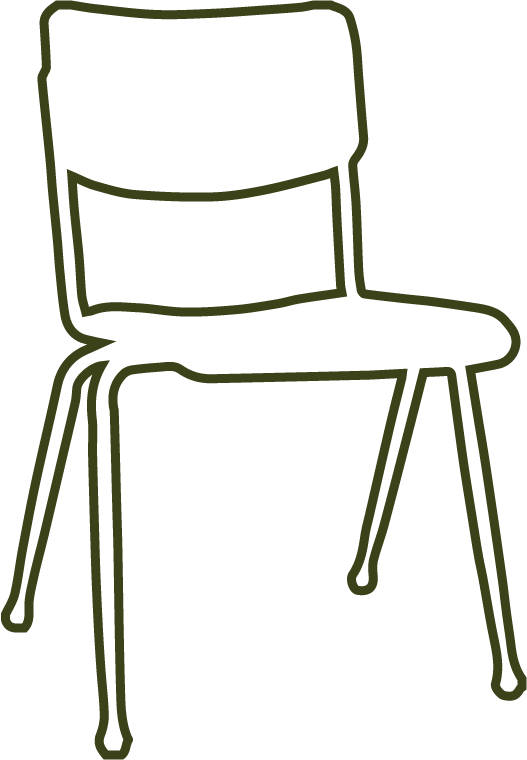Jody: I, too, use fabric to trace an intersection—in a collection of cloth figures that both connect and distance. In her essay “Reviewing Eve,” Nancy Miller describes an installation Eve Sedgwick created in the CUNY Grad Center English Dept. lounge. Sedgwick used cloth figures she had made—stuffed forms dressed in blue leggings and tunics, draped with woven cloth, hung from the ceiling—and distributed a screed she called “in the bardo,” about the “between-state” that immediately follows death. In Tibetan, “bar” means in-between, “do” means suspended, thrown. Miller explicates this:
the figures’ strongest representational ties are to the disorienting and radically denuding bodily sense generated by medical imaging and illness itself, on the one hand; and on the other, to material urges to dress, ornament, to mend, to re-cover and heal.…the wordless figures invited us to meditate on the process of coming to terms with the contours and accidents that shape any given life.Nancy Miller, “Reviewing Eve,” in Regarding Sedgwick: Essays on Queer Culture and Critical Theory, ed. Stephen Barber and David Clark (New York: Routledge, 2002), 222.
I use this installation to evoke my sense of self, emerging from “the contours and accidents” that have shaped my life. I’m someone who tends to see and present myself as (relatively) “normal,” “stable,” a “coherent self.” I speak from the vantage point of “outside disability,” although also striving to be inside it, to better understand.
When I mark myself as “normal,” I not-incidentally conjure you as with me in this, or not: as abnormal. As Ray McDermott and Hervé Varenne suggested some years ago, “no ability, no disability; no disability, no ability”; likewise, no “normal” without “abnormal.”Ray McDermott and Hervé Varenne, “Culture as Disability,” Anthropology and Education Quarterly 26 (1995): 323–48. When I claim “normal,” I tap into the you waiting in the wings to be called forth as somehow, well, fucked up. More recently, Lennard Davis has argued that “all groups, based on physical traits or markings, are selected for disablement by a larger system of regulation and signification.”Davis, “The End of Identity Politics and the Beginning of Dismodernism,” 275. And what if your “trait or markings” are not perceptible, are mental or cognitive rather than physical, or physical but not visibly marked; what if you are not externally recognizable?
I write this, knowing all the while that this is a painting over of cracks and crevices, some dark corners, limits, and scary places that I’ve visited not-so-willingly at particularly challenging times in my life, and some that I’ve not visited. At times, I’ve longed to go there, to these places, but also haven’t wanted to be there; except maybe for brief spurts like under the influence of hallucinogens. So yes, I have always been both resistant and strongly drawn to darker, scarier, unknown, and unknowable places—in myself and in others—and these “places” are actually anywhere: to be found right beneath my feet, gazing down into the depth of grimy sparkle in a city sidewalk.
When I was coming up in the square-plotted walled-in suburb of my childhood, I was fascinated by and intensely drawn to the worlds of people then labeled “handicapped” and “mentally ill”: read their stories voraciously; sought out these “others” in my work as a teenager with other teenagers then called “blind and multiply handicapped,” and later with the heavily gated and sedated so-called “chronically mentally ill” at St. Elizabeth’s, where I fantasized that I could take home (?!) an older woman with multiple diagnoses with whom I was—how can I say it but, in love.
But now I ask myself, how “outside” was this when this “otherness” lurked, yes, right in my own family—my grandfather and uncle suicides, my aunt and cousins profoundly depressed and diagnosed with “psychoses” of various kinds and taking (or not) various cocktails? And here’s a wall: my own parents seeing and presenting themselves as “the stable ones,” and my mom in a constant tension with my aunt over this intense splitting, even now with my aunt many years gone.
In his focus on disability as the physically marked—what artist Riva Lehrer describes as “the great billboard of bodily truth”Riva Lehrer, “Jarred: Self Portrait in Formaldehyde,” talk presented at the Chicago Humanities Festival, November 11, 2014.—Davis does not attend to those mentally “marked” by “accidents of brain chemistry,” as my daughter recently termed her state of being. And if not accidental but plotted somehow, then where in my family album of mental markings are the genomes, and what does this signify?
Telling stories about race, Davis writes, “Eugenics told us one thing about race and genes, social construction told us quite another; but if race is not in the human genome, how then are we to make sense of “genetic markers for disability, defect, and disease?”Davis, “The End of Identity Politics and the Beginning of Dismodernism,” 266. If difference is genetically marked, what then of the differences of mind, perception, interaction that characterize the (how many) mental differences detailed exhaustively in the DSM VI? And what difference does this make, or: what does the story of genetic marking do here? And to what work might it lead me?
Some years ago I had this dream: I was lying in a bunk bed next to my daughter. She must’ve been about sixteen years old. Someone else was in the bed with us too, a male, shadowy. I was just waking up, turning toward her when S opened her mouth and bared a set of large, sharp, and frightening teeth, animal teeth.
At that time S had been diagnosed (first by herself, then by a psychologist) and was dealing with OCD. Being her mom put me face to face, scarily right up close to this “other-ness”: We are in our living room and she’s entering a panic attack—obsessing on a girl in high school who said something, I don’t remember what; she scissors off her new dreadlocks and then screams at her shorn head, frightening my son in the next room; yet another teacher is telling me how silent she is. Most unnervingly, we are travelling and she is convinced we’re being followed, doesn’t feel safe in our hotel room, or on the beach at our favorite pond, or really anywhere; we are at a profound home place for me—very beautiful, and so even more frightening. The darkness is in the beauty in a way that I had been inviting and fighting all my life.
In order to be S’s mother, I need to find in me the capacity to face the parts of her—and myself—that are NOT “normal,” “coherent,” “stable.” To acknowledge in myself the cracks between my aunt and my mom, the gaping holes left by suicides, the internal emptiness of the “strange stranger,” as eco-critic Timothy Morton describes the self.Morton, “Practising Deconstruction in the Age of Ecological Emergency,” 160–61. The non-negotiable demand of this is the greatest gift anyone could have given me. A gift that rescues me from the seductiveness of the ordinary, opens me to the wildness often relegated to animals; that makes searingly evident how we are all implicated in the web of difference, of disability, each “role” dependent upon another.
The postmodern view of identity put forward by Stuart HallStuart Hall, “The Question of Cultural Identity,” in Modernity: An Introduction to Modern Studies, ed. Stuart Hall, David Held, Don Hubert and Kenneth Thompson (Indianapolis: Wiley-Blackwell, 1996), 596–631. and others might suggest that the question of a link between my daughter’s make-up and my own is differently relevant when we see it in the context of partiality and hybridity. Davis takes this notion further, arguing for a “dismodern subject…whose realization is not autonomy and independence but dependency and interdependence…all humans are seen as wounded…impairment is the rule and normalcy is the fantasy.”Davis, “The End of Identity Politics and the Beginning of Dismodernism,” 276. Access, then, might bear re-visioning: what to value, what to desire?
In describing a presentation featuring photographs of jarred fetuses as “specimens of disabled bodies,” Riva Lehrer talks about a “narrative stripping”: “biography is peeled away until nothing is left but naked diagnosis.” A person with spina bifida, she has “no spina bifida elders, to show me how to live.”Lehrer, “Jarred.”
Now recognized and diagnosed more widely, OCD does seem to run in my family, where many of the cousins deal with this mental “marking.” My daughter is the elder, a position that has both challenged and strengthened her as she has become an advisor—on therapy, medication, and daily life. And I am also in this flux, my learning self colliding with her realities, the trash that taunts her on the streets, other material stuff that she interacts with daily—stuff that now enters my realities. And so we are all networked, though so little is understood about what it might mean to have this marking or that; still, the genetic story helps me here to know my humanness, my connections with what is visible to me and what I don’t yet know.
I query, again, the construct of “accommodations.” If “dis/ability” is indeed, as we have posited, a web with all of us implicated, then it seems problematic to conceptualize “accommodations” in terms that rely so strongly on a notion of “regular,” what some people can do that becomes the standard against which “others” cannot.
Play theorist Stuart Brown asks when fidgety-ness became ADHD.Stuart Brown, “Play, Spirit, and Character,” On Being with Krista Tippett, June 19, 2014. This is a schooled designation, too-often raced, classed, and gendered, too-frequently used to contain and isolate boys of color.
What if instead we looked to these children as leaders, who could show us the constrictions of the classroom, help us discover what’s possible in their rough play? What could we learn about access that would meet Davis’s “ethic of liberation” for all of us?
If on some level we are strangers, not only to each other but also to ourselves, and if at the same time we have a capacity to discover this, to become if only for a moment less estranged, it seems problematic that people with “disabilities” should be positioned to do this, to go deep, while others ride the “normal” curve. For instance, as I trace this “stranger-ness,” this incoherence of self, back through my mom’s family, up through my daughter, and into my own self, a different question emerges for me: whether and what I or any of us does with this potentiality. And if it were understood that this is the question and a possibility for all of us—if, for example, we were to recognize all that is going on in a space, say a classroom, that is not “readable” or even necessarily knowable by others or by oneself—our orientation to questions of “access” might also shift dramatically.
In her remembrance of Sedgwick, Nancy Miller writes,
Opening the door to the past as the necessary preliminary to change is never easy, but here it’s not the past tense of memory that hurts the most. [And then Eve herself:] “No, the harder part is telling it now; choosing now to thread the viscera of the labyrinth of
what I didn’t know,
and when I didn’t know it,
and what that felt like.”…Eve explicates what love means to her: the connection of an intimacy without which “both your soul and your whole world might subsist forever in some desert-like state of ontological impoverishment.”Miller, “Reviewing Eve,” 218–19.
And so it is critical that when S bares her animal-teeth, I turn not away but toward her, grafting “abnormal” and “normal,” living out relationality, reveling in the interdependence that Sedgwick calls love. Access—to one another and to ourselves—then becomes a process that we are always starting again and over, reassembling. The bed that my toothy daughter and I share (with a strange male) is a space of unease and promise, a space where we re-create access in our continual willingness to re-engage and re-enter—to teach and learn with each other.

